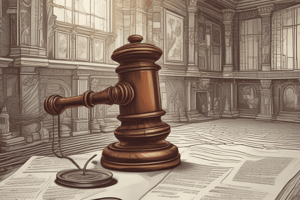Podcast
Questions and Answers
What is the legal principle behind vicarious liability?
What is the legal principle behind vicarious liability?
- Employees can never be held accountable for their actions.
- Employers are directly responsible for all employee actions.
- Employees are solely responsible for their own actions.
- Employers may be held liable for the actions of their employees. (correct)
In vicarious liability, what kind of relationship must exist between the employer and employee?
In vicarious liability, what kind of relationship must exist between the employer and employee?
- Casual relationship
- Close relationship (correct)
- Distant relationship
- Hostile relationship
What must the employee's actions result in for vicarious liability to apply?
What must the employee's actions result in for vicarious liability to apply?
- Harm in the course of employment for the employer's benefit (correct)
- Harm outside the course of employment
- Harm to the general public only
- Harm unrelated to employer's benefit
Why is foreseeability of harm important in vicarious liability cases?
Why is foreseeability of harm important in vicarious liability cases?
What aspect of an employee's duties is crucial in determining unforeseeable harm?
What aspect of an employee's duties is crucial in determining unforeseeable harm?
How can an employer avoid vicarious liability in cases of unforeseeable harm?
How can an employer avoid vicarious liability in cases of unforeseeable harm?
What did the Court of Appeal rule in the case of Home Office v. Kansal (1993) regarding an employer's vicarious liability?
What did the Court of Appeal rule in the case of Home Office v. Kansal (1993) regarding an employer's vicarious liability?
In Woodland v. Essex County Council (1991), why was the employer not held liable for the injury caused by an employee?
In Woodland v. Essex County Council (1991), why was the employer not held liable for the injury caused by an employee?
What did the House of Lords determine in the case of Majrowski v. Guy's and St Thomas' NHS Trust (2006) regarding an employer's liability for unforeseeable harm?
What did the House of Lords determine in the case of Majrowski v. Guy's and St Thomas' NHS Trust (2006) regarding an employer's liability for unforeseeable harm?
What proactive measures must employers take to address potential risks according to implications of unforeseeable harm?
What proactive measures must employers take to address potential risks according to implications of unforeseeable harm?
How does the extent of an employer's control over an employee's actions influence vicarious liability according to legal principles?
How does the extent of an employer's control over an employee's actions influence vicarious liability according to legal principles?
Why is vicarious liability for unforeseeable harm a complex legal concept according to the text?
Why is vicarious liability for unforeseeable harm a complex legal concept according to the text?
Flashcards are hidden until you start studying
Study Notes
Vicarious Liability and Unforeseeable Harm
Vicarious liability refers to a legal principle where an employer or principal may be held liable for the actions of their employees or agents, even when they haven't personally committed the wrongful act. This principle is relevant when discussing unforeseeable harm, which is the occurrence of an injury or damage that was not reasonably anticipated or preventable by the person in question.
Legal Principles
Vicarious liability for unforeseeable harm is based on the following principles:
- Fault of the Employee or Agent: The employee or agent must have engaged in negligent or wrongful behavior.
- Employer's Relationship: The employer must have a close relationship with the employee, such as an employer-employee or principal-agent relationship.
- Profit or Benefit: The employee's actions must have been done for the employer's benefit, and the harm must have occurred in the course of the employment or agency.
Unforeseeable Harm
Unforeseeable harm is a crucial aspect of vicarious liability since it determines whether an employer is liable for the actions of their employees. The key questions in determining unforeseeability are:
- Was the harm outside the ordinary scope of the employee's duties?
- Was the harm unlikely to occur, given the standard of care in the industry or situation?
If the harm can be shown to be unforeseeable, employers might not be held vicariously liable for the employee's actions. However, this defense is not absolute, and courts will still consider the reasonableness of the employer's conduct in managing the risk or preventing the harm.
Case Analysis
The following cases demonstrate how the concepts of vicarious liability and unforeseeable harm are applied in legal contexts:
-
Home Office v. Kansal (1993): The Court of Appeal held that an employer could be held vicariously liable for an unforeseeable assault committed by its employee. In this case, a police employee assaulted a suspect while escorting him to the police station. The Court ruled that the assault was foreseeable, given the nature of the employee's duties, and held the employer liable for the employee's actions.
-
Woodland v. Essex County Council (1991): The House of Lords held that an employer was not liable for an unforeseeable injury caused by an employee. In this case, a schoolboy was injured by a cricket ball thrown by another student. The Court ruled that the injury was unforeseeable, given the standard of care in the school setting and the facts of the incident, and the employer was not held liable.
-
Majrowski v. Guy's and St Thomas' NHS Trust (2006): The House of Lords held that an employer could be held vicariously liable for an unforeseeable injury caused by an employee. In this case, a consultant psychiatrist sexually harassed and assaulted a fellow employee while conducting a telephone interview for the employer. The Court ruled that the sexual misconduct was not within the ordinary scope of the employee's duties, but the employer was liable for the employee's actions because the employer knew of the risk of sexual harassment and failed to take reasonable steps to prevent it.
Implications of Unforeseeable Harm
The concept of unforeseeable harm has several implications for employers and the legal system:
- Employers must be vigilant about potential risks and take proactive measures to prevent them.
- Employers may have a duty to train their employees and provide a safe workplace.
- Courts will consider the extent of an employer's control over an employee's actions when determining vicarious liability.
In conclusion, vicarious liability for unforeseeable harm is a complex legal concept that requires careful consideration of the facts of each case. Courts will use legal principles to determine whether an employer is liable for the actions of their employees, and the concept of unforeseeable harm plays a crucial role in this analysis.
Studying That Suits You
Use AI to generate personalized quizzes and flashcards to suit your learning preferences.




